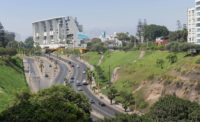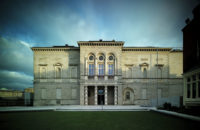Approaching the design for a university building in the Peruvian capital of Lima, Dublin-based Grafton Architects turned to their belief that architecture is the “new geography.” The firm’s founding directors, Yvonne Farrell and Shelley McNamara, also wanted the University of Engineering and Technology, or UTEC—a new single-building institution underwritten by the philanthropic Hochschild family—to capture the essence of the Latin American city, which lies just 12 degrees below the equator, sandwiched between the Pacific Ocean and a desert.
Responding to the existing context, Grafton’s “vertical campus” triumphantly fulfills these goals. And, in the process, the new building has opened up exciting new frontiers for architecture in a country undergoing a physical transformation as a result of strong economic growth.
A close study of Lima’s geography suggested the solution to the challenges posed by a tricky site, a sliver of land above a ravine containing a busy freeway, with the tony high-rise Miraflores district to the north and the more bohemian neighborhood of Barranco to the south. Fascinated by the cliffs from which Lima overlooks the ocean, the architects, who won the commission through an invited competition, looked to create a building that would be a continuation of this natural feature. Approaching UTEC from the water, the concrete structure forms a man-made cliff, echoing the natural ones looming in the distance. The soaring facade dramatically announces the new private university while also acting as a hard shoulder against the din of traffic below.
From its heights, the 10-story building cascades down in a series of patios south toward Barranco. Inspired by the intensive use of terrace farming by pre-Columbian civilizations, this move downplays the monumentalism of the north elevation and produces a sympathetic transition as the building approaches this quiet low-rise neighborhood. The effect was achieved by placing the building’s larger spaces, mainly laboratories, on the lower floors, with the successively smaller volumes of classrooms and professors’ offices on top. This stacking allows for the transformation of the larger volumes’ roofs into garden terraces, onto which the smaller upper spaces have access. The green areas also help the designers achieve their goal of creating a living campus rather than another high-rise box housing an educational institution.
Made of a combination of poured-in-place and precast concrete, the 365,000-square-foot building is supported on its northern side by a series of giant reinforced columns. The component volumes are stacked leaning northward, resulting in a canted structure whose deep overhangs provide shading to the north-facing circulation areas (which, being in the southern hemisphere, receive the intense sunlight), while creating an atrium that gradually reveals its views through the building to those using the main entrance, on the south.
Inspired by Brazilian brutalist master Paulo Mendes da Rocha, the Grafton team has made full use of the possibilities of his concept of the “free section,” which prizes generous, open spaces. A dramatic example of this, UTEC’s atrium cuts through the building both horizontally and vertically, blurring the external and internal and creating a multitude of informal communal areas that are the lifeblood of every university’s existence. Interiors are largely left open to the elements, allowing the ocean breezes to cool the building and minimize the need for air-conditioning.
From within, UTEC creates a thrilling visual experience in which the eye is constantly drawn to dramatic new sightlines, and its sculptural interiors are animated with the movement of air, light, and people through the open spaces, which are framed by geometrical concrete. As one ascends to the upper floors, this effect intensifies, creating the sensation of being suspended within the panoramic views of the city.
“Students will be able to see back to the mountains, the sea, and the desert and know where they are. What we are trying to do in our work is heighten awareness of place,” says Grafton’s Farrell. “We hope it feels like a university in Peru—that it is not like a university in any other place.”
The hanging gardens are only just being planted, and the concrete has yet to acquire the coating of desert dust that the architects hope will further connect the building to its site. And a whole second phase that will double the school’s size (and allow the student body, now at 600, to grow) is yet to be built. Though already a magnificent feat, UTEC’s full potential is still to be realized.
Size: 365,000 square feet (phase I)
Project Cost: $100 million
Completion Date: April 2015
Architect:
Grafton Architects
12-14 College Green
Dublin 2, Ireland
+35316713365
info@graftonarchitects.ie
PeopleClient & Owner: Universidad de Ingeniería y Tecnología - UTEC Architect: Personnel in architect's firm who should receive special credit: Architect of record: Interior designer: Engineers: Electrical: AT Consultores Mechanical: GC Ingenieros Sanitation: Equipo G Consultants: Landscape: Lighting: Acoustical: LEED Certification Advisor: General contractor: Photographer(s): |
ProductsStructural system Manufacturer of any structural components unique to this project: Dynamic Isolation Systems Inc. (Seismic Isolators) Exterior cladding Roofing Windows Glazing Skylights: Corporación Furukawa Doors Wood doors: Pucon Sliding doors: Corporación Furukawa Hardware Interior finishes Demountable partitions: Famargo Cabinetwork and custom woodwork: Flores Valles Drywall and Superboard:- Parqma Floor and wall tile: Decorcentre (Offices, WCs) Resilient flooring: Increte (Stamped Concrete Floor Surfaces), Covering (Vinyl Flooring), Rosello (Stone Flooring) Furnishings Reception furniture: Amura Fixed seating (Auditorium): Figueras Lighting Downlights: Josfel, G.E., EECOL, Lledo Task lighting: Josfel, G.E., EECOL, Lledo Exterior: Josfel, G.E., EECOL, Lledo Dimming System or other lighting controls: Bticino, Leviton Conveyance Plumbing |




















Post a comment to this article
Report Abusive Comment